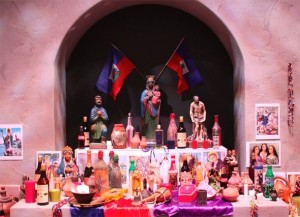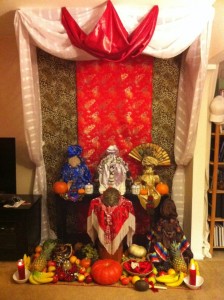All too often,
Santeria is mistakenly confused with other African-derived magical or religious systems. It is very common for people to refer to the practices of
Santería Lucumi (
Lukumi) as “voodoo” by the media, in television and cinema. Movies and television are notorious for lumping all African Diasporic Traditions into one boat, calling them all voodoo and then mocking them or creating sensationalism that is rooted in cultural misinformation. Tack on to this cross-confusion between Voodoo and
Hoodoo and you get a whole other layer of misunderstanding about what Santeria really is. We hope this article will help clarify some confusions, and help set the record straight once and for all.
Santeria and Voodoo are often confused for one another
Both
Santeria and Voodoo are religions but they are not the same thing. Let’s begin with an explanation of Voodoo. First, Voodoo is more properly spelled Vodou or Vodoun. There are two main branches to Vodou, Haitian Vodou and Louisiana (or New Orleans) Vodoun.
Haitian Vodou is an African Diasporic Religion that came together from the traditional African religious practices of several tribes, some of whom were rivals forced to survive and depend on one another under the conditions of slavery. These tribes included the Fon,
Yoruba, Congo and even elements of the native Taino population that surviv
ed in Haiti. These people united their practices in an effort to survive, and created a “regleman” (ritual order) to honor and give each tribe’s spirits their moment of worship. These practices were also influenced through syncretism with French Catholicism. Evidence of this can be seen in the use of Catholic saint images to represent the Lwa (spirits) honored in Vodou. The Lwa (spirits) of Vodou are composed of the Rada Lwa (the vudu and orishas of the Fon and Yoruba people), the Petwo Lwa (the fiery spirits of the Congo, the Taino and modern-Haitian people) and the Gede Lwa (the spirits of the dead). Veves, ornate cornmeal drawings laid out on the ground or on tables, are used to call the Lwa in Vodou, but not in Santeria. Haitian Vodou does have an initiated priesthood, but initiation is not a requirement for participation in the religion and the vast majority of vodouisants are non-initiates. Magical wanga and gris-gris are often used in Haitian Vodou’s magic. Haitian Vodou’s primary liturgical language is Kreyol, the local dialect of Haitian French.

A typical Haitian Vodou altar. Compare this to the photo below of a
Santeria altar and note the differences. Photo by Jeremy Burgins.
Louisiana Vodoun is markedly different from Haitian Vodou. It is more of an amalgamation of religious and magical practices found in the southern United States. This includes some of the Lwa found in Haitian Vodou, a strong presence of the Catholic Saints, and elements of southern folk magic like gris-gris, wanga and mojo bags. There is not a “regleman” in the same manner as Haitian Vodou and there is more of an emphasis on self-made Vodou Queens like the famous Marie Laveau. Louisiana Vodoun has a strong connection with
Spiritualism and shares many magical techniques with
Hoodoo (southern folk magic) – but should not be confused with
Hoodoo. You will see the use of veves (ornate painted symbols) in Louisiana Vodoun, much as in Haitian Vodou. Louisiana Vodoun’s primary liturgical language is English with a bit of French Creole.
Santeria is a religion that evolved in Cuba. It is rooted in the African religious traditions of the
Yoruba people (found in modern-day Nigeria). The followers of
Santeria worship the
orishas, the demi-gods of the
Yoruba people. While there is a veneer of Spanish Catholicism for the outsider, that element quickly drops away once a person has undergone
initiation. The primary involvement of Catholic elements in
Santeria are found in
Espiritismo, a separate religious practice that has been deeply interwoven into
Santeria as of the mid-1900’s.
Santeria is highly
initiatory, secretive and operates under strict religious rules. Participation in the religion is very limited to those who are not
initiated and the great majority of participants are
initiates.
Santeria does NOT use veves or ornate drawn symbols to call the
orishas as are done in Vodou (bullseye-style paintings called osun are used in certain rituals but bear no resemblance to veves).
Santeria’s primary liturgical language is
Lukumí, a late 1800’s dialect of the
Yoruban language interspersed with elements of Cuban Spanish.

A
Santeria altar (throne) to
Chango. Each container has a different
orisha’s mysteries within it, and is covered with decorative cloths, crowns and beaded mazos. Compare this with the Haitian Vodou altar above.
The religious proceedings and magical workings of these religious traditions may have similarities but they are certainly not the same thing. A person
initiated in
Santería will not have the religious rights or permission to participate in Vodou ceremonies like a Vodou initiate would. A person
initiated in Vodou would not have permission and rights to operate in a
Santeria ceremony. Each of these religions is different from one another, and each uses different languages, prayers, songs and rituals from the others. The only commonality between them is the use of
animal sacrifice, and the employment of magical spell work as an integral part of their religious practice, but this is common with any religious practice from sub-saharan Africa.
What is Hoodoo? Is it Voodoo?
Often people mistake
Hoodoo and Vodou. The differenced between them is simple. Vodou is a religion.
Hoodoo is nothing more than
Southern Folk Magic.
Hoodoo uses the magical techniques of the Congo people of Africa without any of the religion. There is no presence of the nkisi,
orishas, or lwa of Africa. In fact, most people who practice
Hoodoo are Protestant Christians. You’ll see hoodoo workers also being called
rootworkers or
conjurers. They make magical charms called mojo bags, or jack balls. They’ll use magical powders, herbal cleansing baths, candles or lamps for spell work. All of this magical work is done while praying Psalms, praying to Jesus and God the Father, and reading from the Bible. While the vast majority of
Hoodoo practitioners are Protestant Christians, there are some some Catholic practitioners who will petition Catholic saints. It’s important to note that they are petitioning the Saints themselves, not as a syncretized image for an African deity or spirit. So Hoodoo is not Voodoo.




